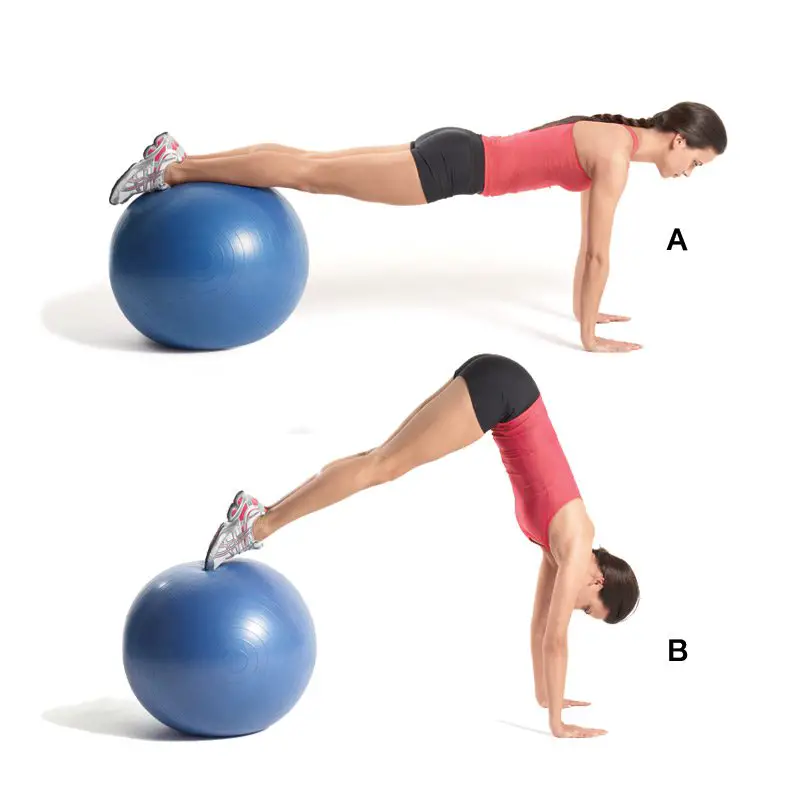This article will cover everything you need to know to add and properly execute the Swiss Ball Pike into your training routine.
It will include a video, image and a written step by step description on how to do this exercise.
Its difficulty level, the equipment you need to do it. The different muscle groups that get worked when you use this exercise.
The benefits you get when adding it to your training routine. Also, some different training cues to use when you are performing it.
Swiss Ball Plank How to Guide
Image Example

Step by Step Description
Step 1: Move to the start position by placing your calves and the tops of your sneakers onto the top of a swiss ball. Place the palms of your hands on the floor directly under your shoulders. Tighten your Core, Quads, Butt and pull your shoulders down and back.
The easiest way to move into this position is to stand in front of the stability ball. Lean over the ball, so your stomach is resting on it. Place your hands on the floor and walk your hands away from the ball.
Your body should now form a straight line from your shoulders to your heels.
Step 2: Keep your legs as straight as you can (remember to keep squeezing your quadriceps). Now bend at the hips and try to pull your feet towards the chest allowing the ball to roll forwards.
Step 3: Now hold your body in the top position for three to four seconds. Roll the ball back to lower your hips. Keep rolling back until your body again forms a straight line.
Step 4: You have now completed one repetition. Repeat for the number of reps and sets that you have selected.
Difficulty Level
The Swiss ball Pike gets rated at an Intermediate fitness level.
You should be able to perform a traditional bodyweight Pike for ten repetitions before attempting to implement this exercise on a stability ball. This will ensure you have enough shoulder strength for this exercise.
Equipment Required
You are going to need access to a Swiss/stability ball to perform this exercise. If you currently do not have access to one you can pick one up from Walmart or Amazon.
Muscles Worked
The Primary muscles worked by this exercise are your Shoulders all heads are active(anterior, medial, and the posterior Deltoids) and the Abdominals. Specifically, your rectus abdominis(the muscle that runs up and down the center of your stomach) gets targeted.
This exercise also works multiple muscle groups in your lower body. Your Quadriceps get contracted to keep your legs in the straight position. The Adductors are also used to keep your legs together.
Benefits of the Swiss Ball Plank
This exercise will help you to improve your balance, stability, and coordination.
The Swiss Ball Pike activates the upper and lower abs as well as the obliques—with minimal recruitment from the hip flexors and lower back. And, it does so better than many other traditional abdominal exercises.
In fact, the only other exercise that showed such high core recruitment is the Swiss ball rollout.
Increasing core strength is proven to reduce your chance of a lower back injury and can even lower/eliminate lower back pain.
Training Tips
Keep your core tight the entire time you are performing this lift. Keeping your core tight will help to prevent your lower back from collapsing at the bottom of the exercise.
Do not allow your knees to bend when you are pulling the ball forwards. Contract your Quadriceps to help keep your legs straight.
Try to keep your elbows locked out the entire time you are performing this lift.
In Closing
Before using this exercise spend some time getting used to being on a stability ball. Most people find learning how to stabilize themselves on the ball the hardest part in the beginning.
To prepare yourself for this exercise there are two different exercises that you should have a firm grasp on.
First, you should be using the plank with your feet on the stability ball (the starting position of this lift) will help you to build your stabilizing muscles strength.
The second is the Pike push-up. Performing the Pike Push-up will ensure your upper body is strong enough to support your weight fully.
If you have never done the Stability Ball Pike before, you should try adding it to your routine for at least a few months to see for yourself all the benefits it has to offer.
You may also like
Looking to gain more strength or lose some weight? We offer free fitness tools to help you reach your fitness goals. Register for free while we are in beta and get free lifetime access to our fitness tools that include an easy to use Calorie Counter, High-Intensity Interval Timer, Multiple Fitness Calculators and our Exercise Logger.